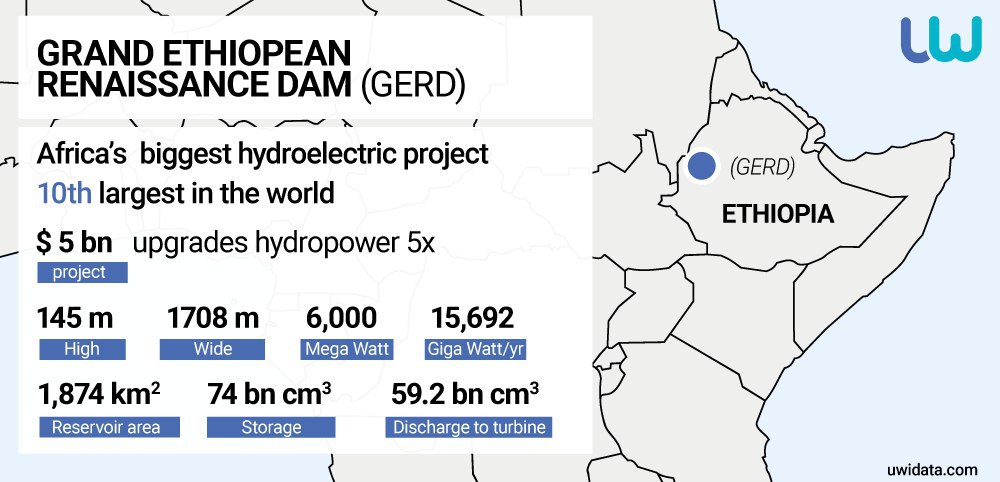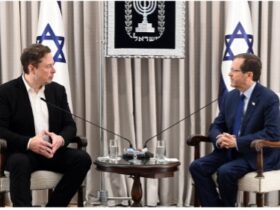The fight against the construction of the Ethiopian GERD dam continues, while the last negotiations of the key stakeholders – Egypt, Sudan, Ethiopia – have reached an impasse. The resolution, drafted by Egypt and endorsed by the Ministers for Foreign Affairs of the Arab League countries, with the exception of Djibouti and Somalia, was adopted via videoconference.
The Arab League on Tuesday called on Ethiopia to “refrain” from starting to fill the reservoir of the large dam it is building on the Nile. That happened on the eve of an agreement with Egypt and Sudan.
Ethiopia, on the other hand, said it would begin filling the dam reservoir in July without even concluding an agreement with Cairo and Khartoum.
The Arab League meeting came immediately after the failure of regular negotiations between the three countries.
The Nile, which flows from south to north and covers 11 countries, is the scene of a serious water crisis in which international conflicts are constantly erupting. More recently, there have even been warnings about a possible water war between Egypt and Ethiopia.
https://uwidata.com/10765-the-end-of-ethiopian-miracle/
Reasons for the confrontation
The GERD, which Ethiopia is building on the Blue Nile, has been a source of great tension between Addis Ababa and Cairo since 2011. Ethiopia hopes to generate more electricity, up to and including exports, while Sudan and Egypt fear that the dam will restrict their access to water downstream and exacerbate their already difficult resource situation.
Egypt depends on the River Nile to provide 95% of the water needed for various purposes such as drinking water supply, domestic use, agriculture, fishing, water transport, tourism, electricity generation from the High Dam and industry.
The Blue Nile, which originates in Ethiopia, connects to the White Nile in Khartoum and forms the Nile that flows through Sudan and Egypt before entering the Mediterranean Sea.
Why is the Nile important?
The Nile, the longest river in the world, is vital to the survival of millions of people. The Nile absorbs about one-third of the world’s fresh water surface, and for thousands of years has served as a source of life for great and historic civilizations in an arid, almost inanimate desert.
In addition to the direct use of water (for direct human use) and navigation, water resources are essential for agriculture. In this matter, such a hidden indicator as water – liters spent on cultivation of agricultural products – is important.
Ahram is comparing this indicator between Egypt and Ethiopia (virtual water in import/local production). Thus, it is estimated that Egypt’s annual virtual water in agriculture and livestock production is 126 BCM, while in Ethiopia the annual virtual water in this sector is about 129 BCM.
Countries with similar populations use about the same amount of water for human consumption. Otherwise, however, the difference is radical: Ethiopia supplies 95% of this water from available water resources (124 BCM), while Egypt could only supply 37% of this water from available water resources (47 BCM). Moreover, Egypt had to spend more than US$12 billion to cover part of its water requirements through imports, and invest even more to cover the remaining 25% of these water requirements through reuse of drainage and treated wastewater, groundwater development and imported feed.
Thus, the publication summarizes, Egypt’s agricultural and livestock water needs are threatened by the launch of the GERD.

Failure of negotiations
Egypt, Sudan and Ethiopia have launched a new round of talks on irrigation deals mediated by Sudan and supervised by the EU, the US and South Africa, where Egypt described recent talks as stumbling because of Ethiopia’s intransigence, Ahram reports. The publication calls Ethiopia’s ambitions an effort at water hegemony power rather than just hydropower.
Egypt and Sudan expressed concern about Ethiopia’s new proposal for mitigation mechanisms to adjust the filling and operation of the dam during dry periods and drought, which affected the lives of millions of citizens in Egypt and Sudan.
Sudan, on the one hand, could benefit from cheaper electricity under Ethiopia’s project, but could also be more likely to be affected by catastrophic floods if the dam fails. Thus, the tension is rising.
Alternatives
Are there any other ways out of this most complicated natural and geopolitically intense situation? If there were simple solutions, Egypt and Ethiopia would not be on the verge of war.
On the one hand, many experts say that it is necessary to develop alternative energy sources.
Many point to the need to consider not only how to maximize energy production, but also how to maintain environmental productivity. One option is to use turbines in the river bed.
Many environmentalists have repeatedly suggested that other renewable energy sources, such as solar and wind, can provide clean electricity at much lower environmental costs.
As an example, a company-waterkeeper in Kenya (Lake Victoria) founded in 2015, is one of three such organizations in the Great Lakes region of Africa that protects the upper reaches of another branch of the Nile, the White Nile.
Working together in different countries, they form a strong grassroots voice for the region and advocate for safe, renewable energy sources, such as solar and wind, which are absent in the NBI’s 10-year strategy (Nile Basin Initiative, a partnership of 10 Nile Basin countries).
Such organizations speak of a long-term problem – the ambitious hydropower development plans they put forward for the region may not benefit 60% of local communities that are not connected to the grid. In fact, NBI recognizes that demand for electricity “will eventually exceed hydropower potential” and that there will eventually be a need for alternative energy sources.
Opponents of eco-activists often say that “clean technology” is currently too expensive for Egypt, which already spends a lot of money to retain its water needs.
There are many experts who focus on investing in more efficient water treatment policies (for Egypt in the first place).
The ????????#Ethiopian Dam: a game bigger than generating #electricity
Op-ed by @IslamFaraghttps://t.co/5rMKZzoSyg #Africa #Nile #Ethiopia #Egypt #Sudan
— United World International (@uwidata) April 7, 2020
Briefly, there are four directions:
-Reuse of drainage and treated wastewater. By 2025, the reuse of domestic and industrial wastewater may reach about 1.5 billion cubic meters per year.
–Cleaning of seawater as an alternative to drinking and agriculture. The problem is the cost of the procedure.
– Drilling of water wells. Water in the desert itself is mostly deep and non-renewable. Potential for pumping out can be almost twice as high as in its present state. Water in reservoirs is also inferior in volume and quality to deep groundwater.
–Construct water condensers near areas of intense evaporation off the coast.
How real is that? That’s a big question. Many people think that sustainable development is closely linked to the availability of renewable freshwater resources. No matter how much a country invests in the development of alternative and unconventional resources, there is nothing to replace natural sustainable renewable fresh water resources.
For example, a relevant comparison of Ethiopia’s share of renewable water resources per capita with that of Egypt’s renewable water resources is crucial.
Thus, in Ethiopia, about 936 billion m3 /year of renewable precipitation falls on average. By subtracting evaporation losses and transboundary waters leaving the country, the remaining 810 BCM/year of renewable water resources are available and contribute to rainfed agriculture, animal husbandry, surface water and groundwater recharge (an important renewable source for domestic water and supplementary irrigation). This water far exceeds Ethiopia’s water needs, which amount to 100 million people.
Egypt, on the other hand, is entitled to 55.5 billion cubic meters of water per year from the Nile Basin for all its uses, including irrigated agriculture, domestic and industrial uses. If we add a small amount of sporadic rainfall over Egypt’s Nile Basin of 1.5 billion dollars, Egypt’s renewable water resources would amount to 57 billion dollars per year. This water is reused and recycled several times to meet some of Egypt’s water needs for more than 100 million people. Egypt must invest in reusing agricultural drainage systems, reusing treated wastewater, desalinating seawater and importing food to meet its water needs.
But what can create a problem is when upstream water-rich countries cut back on the already limited resources of “downstream” countries. And new technologies, while capable of solving Egypt’s problems, are not yet as advanced as they are expensive.
Egypt’s dam?
In recent years there has even been a proposal to build an Egyptian dam of its own in the Shalateen area to compensate for the country’s water loss, but the source of tension between Egypt and Sudan is the dispute over the region. Sudan accused Egypt of occupying that territory, while Egypt claimed that it was rightly under its sovereignty. The subject has not been raised in recent months.
Meanwhile, against the background of the failure of negotiations, Egypt is considering “alternative solutions” in the conflict with Ethiopia, as its representatives say. On June 15, Egypt’s Foreign Minister Sameh Shoukry said during a symposium that recent talks with Ethiopia on the proposed GERD had failed, which in turn would force Egypt to look for “other alternatives,” Egypt Today writes.
Is it really about electricity?
Many experts point out that perhaps in the case of Ethiopia it is not about electricity: this argument is refuted by the almost total absence of electricity in the country. It is possible that electricity will only enrich the Ethiopian elite, which will mainly sell it to other countries. Thus, the whole project is indeed selfish and will not produce the stated results for the Ethiopian people.
As Islam Farag wrote in a recent UWI article, the Ethiopian authorities have reduced the number of turbines that produce electricity from the dam from 16 to 12, which means that the amount of electricity produced will be reduced to a level that makes it economically inefficient, and thus confirms that its purpose is not to produce electricity at all.
https://uwidata.com/9688-the-ethiopian-dam-a-game-bigger-than-generating-electricity/
If we add these two developments to Ethiopia’s avoidance of a recent agreement between countries sponsored by the US Treasury and the World Bank, we suspect that Addis Ababa is only being delayed in order to avoid any written commitments guaranteeing no harm to Cairo, and that Ethiopia is trying to achieve non-development goals not supported by international law.
Egyptian officials privately claim that the goal is not just water, and that Ethiopia is seeking to weaken Egypt’s political and geopolitical weight by striking at its development, giving Addis Ababa political leverage with a rival state, giving it more influence than any other foreign government.
It is possible that one of the goals of the Ethiopian authorities is to take control of most of the Nile and make Egypt dependent on its decisions (in the long run, it is a political force). Even more alarming is what the Foreign Minister has called the Nile “our river”, describing the common transboundary resource as “our own water resources”.
Egypt’s energy industry – potential assistance
A possible solution would have been a mutual agreement between Egypt and Ethiopia before construction of the dam. Egypt is strong in the electricity sector (by contracting with different countries to develop the direction, such as France, it has strengthened its position in this matter), but fears losing water. Ethiopia has enough water but no electricity in the villages.
The countries could fill each other’s resource/energy gap without conflict.
When electricity was first introduced in Egypt in 1893, it was produced and distributed exclusively by private companies. In 1962, electricity production, transmission and distribution were nationalized. Between 1996 and 2000, a number of laws and presidential decrees were adopted to reorganize and regulate the growing electrical industry. Egypt also had difficult periods in power outages: in order to cope with the extremely high demand for electricity, power cuts and interruptions were introduced in summer 2012, which caused great tension between the government and the people of Egypt.
Plus, there are other energy resources that could be of use to Ethiopia, such as oil. Egypt is an important non-OPEC energy producer. It has the sixth largest proven oil reserves in Africa.
As for gas energy in Egypt, the process is also active: in March 2015, BP signed a $12 billion deal to develop Egypt’s natural gas fields for domestic sales starting in 2017. In September 2015, Eni announced the discovery of Zohr, the largest gas field in the Mediterranean. The field is estimated to account for approximately 30 trillion cubic feet of total available gas.
Egypt also has the potential to implement projects based on nuclear power, which is clean enough. In March 2008, Egypt signed an agreement with Russia on the use of nuclear energy for peaceful purposes. In 2015, contracts were signed with Russia to begin construction of the El Dabaa plant.
Egypt’s current energy strategy (adopted by the Supreme Energy Council in February 2008) envisages an increase in renewable energy production to 20% of the total by 2020. The High Energy Council’s goal of increasing the share of renewable energy to 20 per cent by 2020 is expected to be largely achieved through wind power development. Wind power is expected to reach 12% of total power generation, while hydropower and solar power are expected to account for the remaining 8%.
Natural exchange
What prevents countries from having “natural” exchanges? Egypt could share its experience, experts and use the help of mediators between Ethiopia and countries with experience in energy. Of course, it would be much easier for Ethiopia to set up a dam and get simple energy, but is this effort worth a potential war in the region? Egypt may be exaggerating the risks, but the most important thing for it now is to buy time and prepare for a potential drop in water levels, and Ethiopia does not want to postpone launch.
Countries should have agreed to cooperate much earlier, before the construction of GERD, but even now it is not too late – a compromise can be found by building a scheme of mutually beneficial cooperation, and on the Ethiopian side it could be helping to supply water to Egypt and delaying the launch of the dam until the deal is reached.

















Leave a Reply